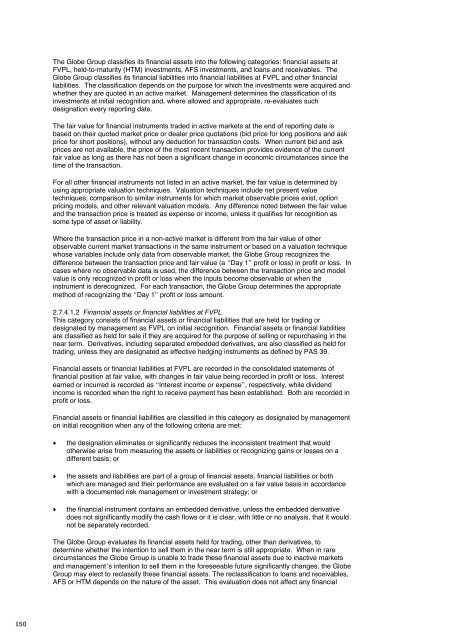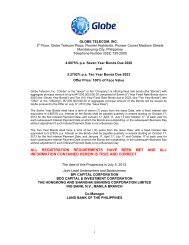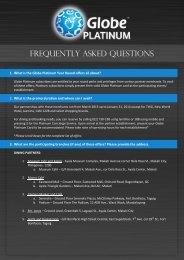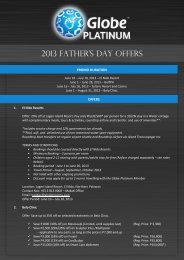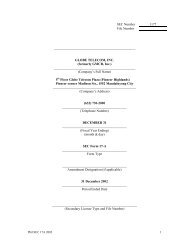here - Ayala
here - Ayala
here - Ayala
Create successful ePaper yourself
Turn your PDF publications into a flip-book with our unique Google optimized e-Paper software.
Globe 2012 annual report<br />
financial report<br />
The Globe Group classifies its financial assets into the following categories: financial assets at<br />
FVPL, held-to-maturity (HTM) investments, AFS investments, and loans and receivables. The<br />
Globe Group classifies its financial liabilities into financial liabilities at FVPL and other financial<br />
liabilities. The classification depends on the purpose for which the investments were acquired and<br />
whether they are quoted in an active market. Management determines the classification of its<br />
investments at initial recognition and, w<strong>here</strong> allowed and appropriate, re-evaluates such<br />
designation every reporting date.<br />
The fair value for financial instruments traded in active markets at the end of reporting date is<br />
based on their quoted market price or dealer price quotations (bid price for long positions and ask<br />
price for short positions), without any deduction for transaction costs. When current bid and ask<br />
prices are not available, the price of the most recent transaction provides evidence of the current<br />
fair value as long as t<strong>here</strong> has not been a significant change in economic circumstances since the<br />
time of the transaction.<br />
For all other financial instruments not listed in an active market, the fair value is determined by<br />
using appropriate valuation techniques. Valuation techniques include net present value<br />
techniques, comparison to similar instruments for which market observable prices exist, option<br />
pricing models, and other relevant valuation models. Any difference noted between the fair value<br />
and the transaction price is treated as expense or income, unless it qualifies for recognition as<br />
some type of asset or liability.<br />
W<strong>here</strong> the transaction price in a non-active market is different from the fair value of other<br />
observable current market transactions in the same instrument or based on a valuation technique<br />
whose variables include only data from observable market, the Globe Group recognizes the<br />
difference between the transaction price and fair value (a “Day 1” profit or loss) in profit or loss. In<br />
cases w<strong>here</strong> no observable data is used, the difference between the transaction price and model<br />
value is only recognized in profit or loss when the inputs become observable or when the<br />
instrument is derecognized. For each transaction, the Globe Group determines the appropriate<br />
method of recognizing the “Day 1” profit or loss amount.<br />
2.7.4.1.2 Financial assets or financial liabilities at FVPL<br />
This category consists of financial assets or financial liabilities that are held for trading or<br />
designated by management as FVPL on initial recognition. Financial assets or financial liabilities<br />
are classified as held for sale if they are acquired for the purpose of selling or repurchasing in the<br />
near term. Derivatives, including separated embedded derivatives, are also classified as held for<br />
trading, unless they are designated as effective hedging instruments as defined by PAS 39.<br />
Financial assets or financial liabilities at FVPL are recorded in the consolidated statements of<br />
financial position at fair value, with changes in fair value being recorded in profit or loss. Interest<br />
earned or incurred is recorded as “Interest income or expense”, respectively, while dividend<br />
income is recorded when the right to receive payment has been established. Both are recorded in<br />
profit or loss.<br />
Financial assets or financial liabilities are classified in this category as designated by management<br />
on initial recognition when any of the following criteria are met:<br />
the designation eliminates or significantly reduces the inconsistent treatment that would<br />
otherwise arise from measuring the assets or liabilities or recognizing gains or losses on a<br />
different basis; or<br />
the assets and liabilities are part of a group of financial assets, financial liabilities or both<br />
which are managed and their performance are evaluated on a fair value basis in accordance<br />
with a documented risk management or investment strategy; or<br />
the financial instrument contains an embedded derivative, unless the embedded derivative<br />
does not significantly modify the cash flows or it is clear, with little or no analysis, that it would<br />
not be separately recorded.<br />
The Globe Group evaluates its financial assets held for trading, other than derivatives, to<br />
determine whether the intention to sell them in the near term is still appropriate. When in rare<br />
circumstances the Globe Group is unable to trade these financial assets due to inactive markets<br />
and management’s intention to sell them in the foreseeable future significantly changes, the Globe<br />
Group may elect to reclassify these financial assets. The reclassification to loans and receivables,<br />
AFS or HTM depends on the nature of the asset. This evaluation does not affect any financial<br />
assets designated at FVPL using the fair value option at designation because these instruments<br />
cannot be reclassified after initial recognition.<br />
Derivatives embedded in host contracts are accounted for as separate derivatives and recorded at<br />
fair value if their economic characteristics and risks are not closely related to those of the host<br />
contracts and the host contracts are not held for trading or designated at fair value though profit or<br />
loss. These embedded derivatives are measured at fair value with changes in fair value<br />
recognised in profit or loss. Reassessment only occurs if t<strong>here</strong> is a change in the terms of the<br />
contract that significantly modifies the cash flows that would otherwise be required.<br />
2.7.4.1.3 HTM investments<br />
HTM investments are quoted non-derivative financial assets with fixed or determinable payments<br />
and fixed maturities for which the Globe Group’s management has the positive intention and ability<br />
to hold to maturity. W<strong>here</strong> the Globe Group sells other than an insignificant amount of HTM<br />
investments, the entire category would be tainted and reclassified as AFS investments. After initial<br />
measurement, HTM investments are subsequently measured at amortized cost using the effective<br />
interest rate method, less any impairment losses. Amortized cost is calculated by taking into<br />
account any discount or premium on acquisition and fees that are an integral part of the effective<br />
interest rate. Gains and losses are recognized in profit or loss when the HTM investments are<br />
derecognized or impaired, as well as through the amortization process. The amortization is<br />
included in “Interest income” in the consolidated statements of comprehensive income. The<br />
effects of restatement of foreign currency-denominated HTM investments are recognized in profit<br />
or loss.<br />
T<strong>here</strong> are no outstanding HTM investments as of December 31, 2012, 2011 and 2010.<br />
2.7.4.1.4 Loans and receivables<br />
Loans and receivables are non-derivative financial assets with fixed or determinable payments that<br />
are not quoted in an active market. They are not entered into with the intention of immediate or<br />
short-term resale and are not classified as financial assets held for trading, designated as AFS<br />
investments or designated at FVPL.<br />
This accounting policy relates to the consolidated statements of financial position caption<br />
“Receivables”, which arise primarily from subscriber and traffic revenues and other types of<br />
receivables, “Short-term investments”, which arise primarily from unquoted debt securities, and<br />
other nontrade receivables included under “Prepayments and other current assets” and loans<br />
receivables included under “Other noncurrent assets”.<br />
Receivables are recognized initially at fair value. After initial measurement, receivables are<br />
subsequently measured at amortized cost using the effective interest rate method, less any<br />
allowance for impairment losses. Amortized cost is calculated by taking into account any discount<br />
or premium on the issue and fees that are an integral part of the effective interest rate.<br />
Penalties, termination fees and surcharges on past due accounts of postpaid subscribers are<br />
recognized as revenues upon collection. The losses arising from impairment of receivables are<br />
recognized in the “Impairment losses and others” account in the consolidated statements of<br />
comprehensive income. The level of allowance for impairment losses is evaluated by<br />
management on the basis of factors that affect the collectability of accounts (see accounting policy<br />
on 2.7.4.2 Impairment of Financial Assets).<br />
Short-term investments, other nontrade receivables and loans receivable are recognized initially at<br />
fair value, which normally pertains to the consideration paid. Similar to receivables, subsequent to<br />
initial recognition, short-term investments, other nontrade receivables and loans receivables are<br />
measured at amortized cost using the effective interest rate method, less any allowance for<br />
impairment losses.<br />
2.7.4.1.5 AFS investments<br />
AFS investments are those investments which are designated as such or do not qualify to be<br />
classified or designated as at FVPL, HTM investments or loans and receivables. They are<br />
purchased and held indefinitely, and may be sold in response to liquidity requirements or changes<br />
in market conditions. They include equity investments.<br />
After initial measurement, AFS investments are subsequently measured at fair value. Interest<br />
earned on holding AFS investments are reported as interest income using the effective interest<br />
rate. The unrealized gains and losses arising from the fair value changes of AFS investments are<br />
150 151


